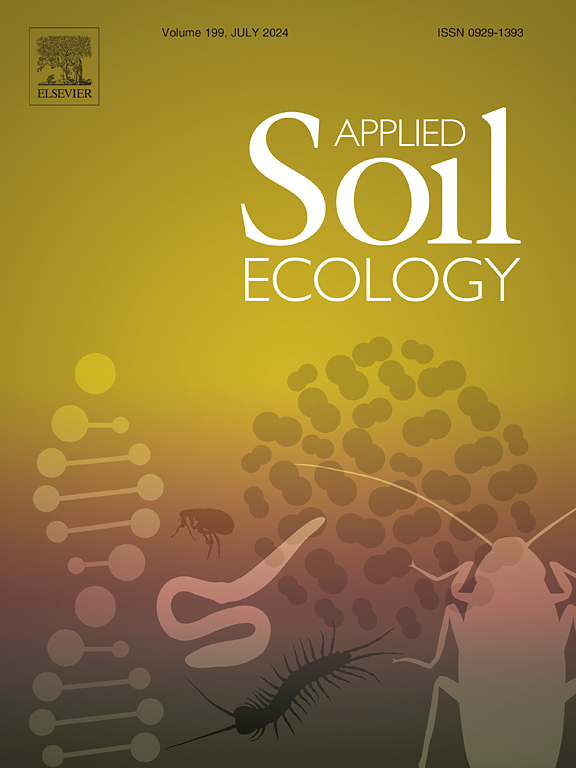Combined effects of cropping alfalfa (Medicago sativa L.) on the soil pore structure, microbial communities and organic carbon fractions in saline soils
IF 4.8
2区 农林科学
Q1 SOIL SCIENCE
引用次数: 0
Abstract
Soil salinity is a global environmental issue that poses a serious threat to soil quality harming the terrestrial ecosystems, and the Songnen Plain in Northeast China exemplifies saline-alkaline soils. Alfalfa has played an important role in the improvement of saline and alkaline land in the Songnen Plain, which has significantly increased the agricultural production potential of saline and alkaline land. However, limited studies have investigated the specific effects of alfalfa on soil aggregate pore structure, microbial community composition, and soil carbon content, which are critical factors in soil restoration. Accordingly, using high-throughput sequencing and computed tomography (CT) to examine how alfalfa cropping impacts these key soil properties, specifically, soil aggregate porosity, microbial diversity, and soil organic carbon content. The findings revealed that cropping alfalfa significantly increased the porosity of the topsoil, especially the increase in macropores (P> 100 μm) was more pronounced. Topsoil organic carbon content and its carbon fractions were significantly increased, with soil organic carbon (SOC), mineral-associated organic carbon (MAOC), particulate organic carbon (POC), readily oxidizable carbon (ROC), and dissolved organic carbon (DOC) were all increased. Alfalfa cropping also enhanced microbial community structure, as evidenced by larger and more interconnected microbial co-occurrence networks. In the topsoil, the number of nodes increased by 787 and 803, while the number of edges grew by 1067 and 8186 in bacterial and fungal networks, respectively. Similarly, in the subsoil, bacterial and fungal networks exhibited increases of 1819 and 289 nodes, and 11,422 and 2372 edges, respectively. These complex networks demonstrated greater resilience to saline-alkaline stress, with keystone microbial species influenced by organic carbon fractions driving community assembly primarily through stochastic processes. The study also highlighted significant vertical spatial variability, with alfalfa cropping having a more pronounced effect on topsoil compared to subsoil. In addition, cropping alfalfa improved the physical and chemical properties of saline soils, enhanced soil aggregate stability, increased macropore proportions, boosted microbial diversity, and contributed to the ecological restoration of saline soils. These findings provide valuable insights into the mechanisms by which alfalfa improves saline soils and offer a promising approach for the restoration and sustainable management of saline-alkaline ecosystems.

种植紫花苜蓿对盐碱地土壤孔隙结构、微生物群落和有机碳组分的综合影响
土壤盐碱化是一个全球性的环境问题,严重威胁土壤质量,危害陆地生态系统,松嫩平原是盐碱化土壤的典型代表。苜蓿在松嫩平原盐碱地改良中发挥了重要作用,显著提高了盐碱地的农业生产潜力。然而,苜蓿对土壤团聚体孔隙结构、微生物群落组成和土壤碳含量的具体影响研究有限,而这些是土壤恢复的关键因素。因此,使用高通量测序和计算机断层扫描(CT)来研究苜蓿种植如何影响这些关键的土壤特性,特别是土壤团聚体孔隙度,微生物多样性和土壤有机碳含量。结果表明:种植苜蓿显著增加了表层土壤孔隙度,尤其是大孔隙(P>;100 μm)更为明显。表层土壤有机碳含量及其碳组分显著增加,土壤有机碳(SOC)、矿物伴生有机碳(MAOC)、颗粒有机碳(POC)、易氧化碳(ROC)和溶解有机碳(DOC)均增加。紫花苜蓿种植也增强了微生物群落结构,这证明了更大、更相互关联的微生物共生网络。表层土壤细菌和真菌网络的节点数分别增加了787和803个,边缘数分别增加了1067和8186个。在下层土壤中,细菌和真菌网络分别增加了1819和289个节点,增加了11422和2372条边。这些复杂的网络显示出对盐碱胁迫更强的弹性,受有机碳组分影响的关键微生物物种主要通过随机过程驱动群落组装。该研究还强调了显著的垂直空间变异,与底土相比,苜蓿种植对表土的影响更为明显。此外,种植紫花苜蓿改善了盐渍土的理化性质,提高了土壤团聚体稳定性,增加了大孔比例,增加了微生物多样性,有助于盐渍土的生态恢复。这些发现为紫花苜蓿改善盐碱地的机制提供了有价值的见解,并为盐碱生态系统的恢复和可持续管理提供了有希望的方法。
本文章由计算机程序翻译,如有差异,请以英文原文为准。
求助全文
约1分钟内获得全文
求助全文
来源期刊

Applied Soil Ecology
农林科学-土壤科学
CiteScore
9.70
自引率
4.20%
发文量
363
审稿时长
5.3 months
期刊介绍:
Applied Soil Ecology addresses the role of soil organisms and their interactions in relation to: sustainability and productivity, nutrient cycling and other soil processes, the maintenance of soil functions, the impact of human activities on soil ecosystems and bio(techno)logical control of soil-inhabiting pests, diseases and weeds.
 求助内容:
求助内容: 应助结果提醒方式:
应助结果提醒方式:


